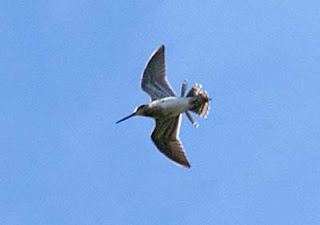ISSN 0967-1870: issue 181
Features
Vinicombe, K E. Green and Wood Sandpipers (Tringa ochropus and T glareola) [Identification of these two similar species at a glance]
Madge, G. Trailing a tori [The work of the Albatross Task Force on longline trawlers in the South Atlantic]
Watts, O. The heat is on [Mitigating the effects of climate change on Britain’s birds]
McKenzie, D. Losses and gains [How global warming might affect Britain’s breeding birds and scarce visitors]
Young, S. Taking the slow road [Bird photography: using a slow shutter speed to great effect] Better Birding
Resources – water on the brain; other wildlife – is it a bird or a bat?; bat walks; feeding – bills of fare; behaviour – feather dusters; must see – Cirl Bunting; on the move – southward bound; what’s on – July events; optical events – July guide; birding courses and workshops; tide tables for July for Britain and Ireland
Where to watch birds
Chubb, J. Axe Estuary, Devon
Duffin, B. Titchfield Haven, Hampshire
Ahmed, R. Bishop Middleham, Co Durham
Pullan, D. Handa Island, Highland
Reader Holidays
Öland and Falsterbo, Sweden: 22-29 September 2007
Azores: 6-13 October 2007 Panama: 11-20/23 October 2008
News and related itemsNews digest – Common Cranes breed in Suffolk; farmland birds decline;1200 bird species face extinction; doves downed in Cyprus; police investigate harrier incident
Fraser, M. ListCheck – updating the world view of birds. [Split: Common Bush Tanager (Chlorospingus opthalmicus). Potential splits: Madeiran Storm-petrel (Oceanodroma castro); Grey Parrot (Psittacus erithacus). Relationships: white-eyes (Zosterops).]
Tools of the trade Product reviews: Pentax 8x43 and 10x43 DCF ED binoculars
Brochure watch: Birdquest 2008/09 Reader holiday report: Bulgaria, February 2007
Internet birding: satellite mapping, new
Birdwatch news blog, new-look websites
Book/DVD reviews: Raptors: a Field Guide to Survey and Monitoring by Jon Hardey, Humphrey Crick, Chris Wernham, Helen Riley, Brian Etheridge and Des Thompson (Stationary Office TSO); The Selborne Pioneer: Gilbert White as Naturalist and Scientist, a Re-examination by Ted Dadswell (Open Gate); Life on the Wing by Brutus Östling and Magnus Ullman (Collins)
Accounts of recent rarities in Britain and IrelandStaff writer. After three decades, the wait finally ends. [White-tailed Lapwing (Vanellus leucurus), Caerlaverock WWT, Dumfries & Galloway 6-8 June 2007]
McKenzie, D. Booby prize for Wight watchers [Masked Booby (Sula dactylatra), English Channel, May 2007]
Filby, D. The ultimate twitch [Black-browed Albatross (Diomedea melanophris), Sula Sgeir, Outer Hebrides, May 2007]
Butcher, R. Reality check for daydreamer [Audouin’s Gull (Larus audouinii), Dungeness, Kent, 16 May 2007)
Monthly highlights summary: May 2007
Recent reports
Monthly round-ups from eight regions in Britain, and from Northern Ireland and the Republic of Ireland, May 2007, including photos of Black Scoter (Melanitta americana), Audouin’s Gull (Larus audouinii), Squacco Herons (Ardeola ralloides), Wilson’s Phalarope (Phalaropus tricolor), Pallas’s Warbler (Phylloscopus proregulus), Woodchat Shrike (Lanius senator), Eagle Owl (Bubo bubo), Baltimore Oriole (Icterus galbula), Calandra Lark (Melanocorypha calandra) and Little Crake (Porzana parva).
Highlights summary for the Western Palearctic in April 2007, including photos of Great Rosefinch (Carpodacus rubicilla) in Georgia, Great Snipe (Gallinago media) in Lesvos, White-winged Black Terns (Chlidonias leucopterus) in The Netherlands, a hybrid shrike (Lanius sp) in Malta, Stone-curlew (Burhinus oedicnemus) on Heligoland, Germany, and Spotted Sandpiper (Actitis macularia) in Denmark.












